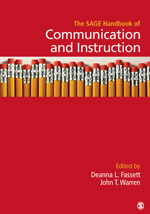Deanna L. Fassett and John T. Warren
Introduction: Critical Communication Pedagogy
SECTION I: Communication Education
Ann Darling, Section Editor
Chapter 1: Communication Education: An Association of Radicals
Keith Nainby
Chapter 2: The Philosophical and Methodological Foundations of Communication Education
Deanna D. Sellnow and Jason M. Martin
Chapter 3: The Basic Course in Communication: Where Do We Go From Here?
Deanna P. Dannels
Chapter 4: Communication Across the Curriculum Problematics and Possibilities: Standing at the Forefront of Educational Reform
Katherine Grace Hendrix
Chapter 5: Communication and the Preparation of Future Faculty: Learning to Manage Incoherencies
Matt McGarrity
Chapter 6: Communication Textbooks: From the Publisher to the Desk
Jami L. Warren and Timothy L. Sellnow
Chapter 7: Learning through Service: The Contributions of Service Learning to the Communication Discipline
SECTION II: Instructional Communication
Scott A. Myers, Section Editor
Chapter 8: Instructional Communication: Section Introduction
Jennifer H. Waldeck, Timothy G. Plax, and Patricia Kearney
Chapter 9: Philosophical and Methodological Foundations of Instructional Communication
Rebecca M. Chory and Alan Goodboy
Chapter 10: Power, Compliance, & Resistance in Classroom
Paul L. Witt, Paul Schrodt, and Paul D. Turman
Chapter 11: Instructor Immediacy: Creating Conditions Conducive to Classroom Learning
Melanie Booth-Butterfield and Melissa Bekelja Wanzer
Chapter 12: Humor and Communication in Instructional Contexts: Goal Oriented Communication
Scott Titsworth & Joseph P. Mazer
Chapter 13: Clarity in Teaching and Learning: Conundrums, Consequences and Opportunities
Matthew M. Martin & Scott A. Myers
Chapter 14: The Relational Side of Instructional Communication: An Examination of Instructors? Presentational Communication Traits
SECTION III: Critical Communication Pedagogy
John T. Warren and Deanna L. Fassett, Section Editors
Chapter 15: Critical Communication Pedagogy: A Reframing of the Field
Leda Cooks
Chapter 16: The (Critical) Pedagogy of Communication and the (Critical) Communication of Pedagogy
Bryant Keith Alexander
Chapter 17: Critical/Performative/Pedagogy: Performing Possibility as a Rehearsal for Social Justice
Bernadette Marie Calafell
Chapter 18: When Will We All Matter?: Exploring Race, Pedagogy and Sustained Hope For The Academy
Jennifer S. Simpson
Chapter 19: Critical Race Theory and Critical Communication Pedagogy
Karen Lovaas
Chapter 20: Communication & Sexuality
Radhika Gajjala, Natalia Rybas, Yahui Zhang
Chapter 21: Producing Digitally Mediated Environments as Sites for Critical Feminist Pedagogy









